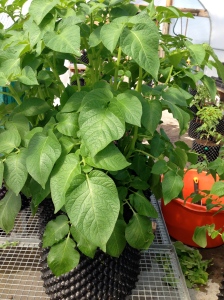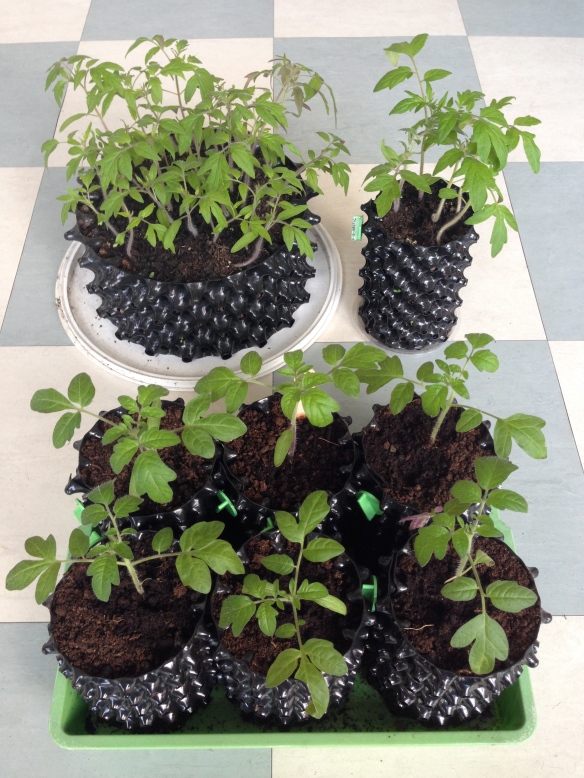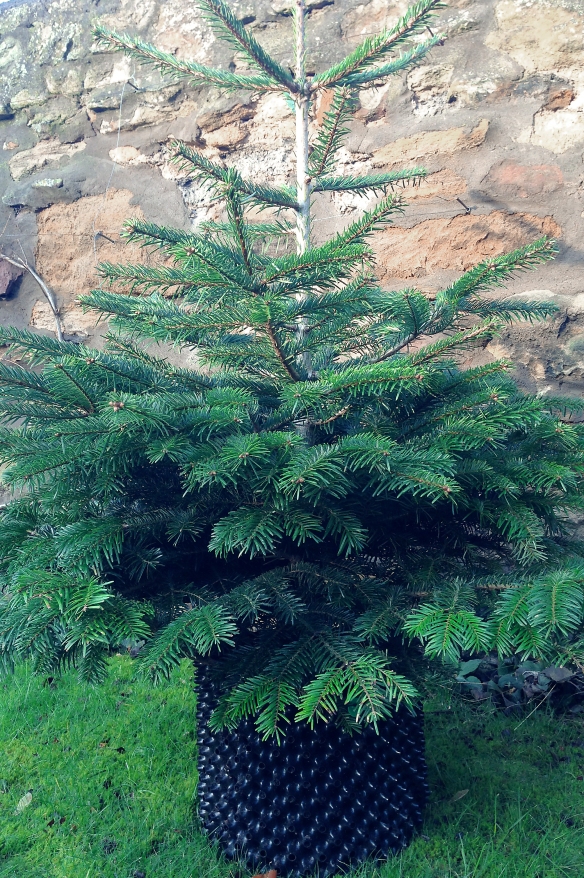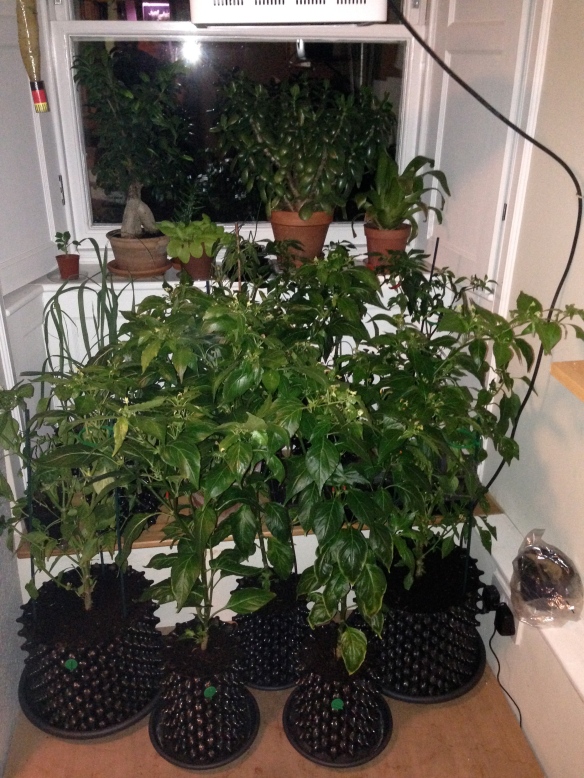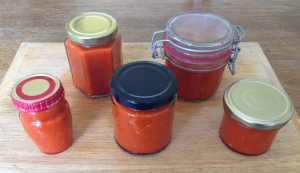8th January
It is the start of a new year and time to buy seed and plan what will grow in the garden during the coming season. Among the first things I will be sowing are onions, chillis and cut and come again salads, the hardier salads such as mustard, rocket, mizuna and beet should give some welcome fresh leaves in early spring. I hope Air-Pot seed trays will help these salads establish good strong roots so the little plants can come back after several cuttings. I have made a grow light and will provide bottom heat to nurse the early sowings through their first gloomy weeks.

One job I did do was to pot on three small blueberry bushes into 7.5 litre pots because the older bush (pictured on the left) I had in an Air-Pot container did so well last year, it put on masses of growth and should be big enough to give a decent crop this year. Because Blueberries are very particular about soil type I cannot easily grow them in the ground so they will remain in pots to fruition, I think a big container makes sense for them, I did hear that a bathtub is about right for 2 bushes, I think a big Air-pot will be better than a bathtub as they will not get root bound and they should develop well and crop quicker.
16th November
I have had a good tidy up in the greenhouse so I thought I would look at the roots of some Air-Pot grown plants. I had got my hands on some 7.5 litre Air-Pot containers in the summer so was able to try a tomato, a cucumber and a couple of capsicums. The roots of the tomato and cucumber had already rotted away but the pepper plants were still alive and the roots were quite impressive, they had completely filled the container with no sign of any circling.

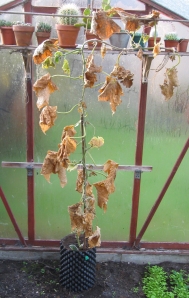
The outstanding success this year was the greenhouse cucumber plant, it reached the roof and produced 2 flushes of huge, perfect cucumbers, around 8 in total. The tomato plant gave us a good amount of orange plum type fruits, and even the capsicums fruited better than my previous attempts. To improve the yield and extend the season I think the tomato and cucumber needed a bigger container such as the 10 or 14 litre Air-pot for tender crops. These are wider than the standard shape and better suited to shallow rooting plants like tomatoes and cucumbers, the 7.5 litre container seems big enough for the capsicums but I only got 4 or 5 peppers, a bit of heat early in the season might be what they need to boost the number of fruits.
15th November
Yesterday I went to a National Vegetable Society (Scottish Branch) seminar where I helped man the Air-Pot stall. The members who attended and the speakers had a truly outstanding level of expertise and knowledge about vegetable growing, and many of these expert growers had good opinions of Air-pot containers. Several people went away with Air-Pot potato towers after the presentation about growing potatoes for exhibition, I am really looking forward to seeing if I can produce a very early crop in these next year.
At the seminar I picked up a tip for ridding homemade compost of unwanted brandling worms (see previous post). Simply heap the compost into a point, the worms will migrate down from the narrow peak where it is too dry and light for them. Remove the worm free peak, then repeat until just the soggy bottom remains, full of worms which can be returned to the compost bin. This tip came from an ex-worm farmer, currently selling beetle faeces (I bought a tub). Amazing what you pick up at these events!
1st November
This week I have been busy turning a very full compost bin, giving all the partially rotted material a good mix and allowing me to get at the lovely crumbly humus at the bottom.
Next year I intend to grow quite a few plants in Air-Pot containers with some of my homemade compost in the growing medium. A homemade mix will be particularly worthwhile in big containers like the Air-Pot potato tower. Buying bags of sterile potting compost is fine for seed sowing and small containers but will be costly for the bigger containers.
I have to admit that my compost is a bit rough and twiggy. I believe this can be a particular problem when using an Air-Pot container because the growing medium must nestle into the conical shaped studs.
So I need to sieve the compost to a maximum particle size of about 20 mm. A quick rummage through my scrap pile turned up a perfect piece of metal mesh with 20 mm x 20 mm holes, which luckily just fitted on my wheelbarrow. Simply dumping compost onto the mesh was a bit messy so I made a simple wooden frame to contain the compost and hold the mesh flat.

It is an easy job to riddle the compost through with the back of a rake. The sieve catches sticks, lumps of moss, avocado pips and mango stones etcetera, which I chuck on the burn pile or back on the midden.

I am quite pleased with the dark brown refined compost, it really smells quite delicious; nutty with a spicy note. I will probably combine it with a bit of loam and grit or vermiculite, and a handful of fertiliser such as blood, fish and bone. I just need to persuade the red brandling worms to move out. Spreading the compost in the sun might discomfit them and make them seek a shady spot where I can easily gather them up?
 Too many chilli plants crammed into limited greenhouse space meant many did not get potted on soon enough, but even in the 1 litre Air-Pot prop-pot I was impressed that plants grew well and fruited despite being somewhat “bonsaied”. The optimum Air-Pot container for most chillies grown as annuals is the small 3 litre size, but very vigorous types and overwintered plants can benefit from a bigger pot. The cool tolerant Rocoto chillies (Capsicum pubescens) will go into the 9 litre medium pots next year if they survive the winter; apparently they can grow into quite substantial bushes over a few years.
Too many chilli plants crammed into limited greenhouse space meant many did not get potted on soon enough, but even in the 1 litre Air-Pot prop-pot I was impressed that plants grew well and fruited despite being somewhat “bonsaied”. The optimum Air-Pot container for most chillies grown as annuals is the small 3 litre size, but very vigorous types and overwintered plants can benefit from a bigger pot. The cool tolerant Rocoto chillies (Capsicum pubescens) will go into the 9 litre medium pots next year if they survive the winter; apparently they can grow into quite substantial bushes over a few years.

















